Chapter 1 Introduction to Corporate Finance
Chapter 1 Introduction to Corporate Finance
1A. Select the correct answer from the options given below and rewrite the statements.
Question 1.
_____________ is related to money and money management.
(a) Production
(b) Marketing
(c) Finance
Answer:
(c) Finance
Question 2.
Finance is the management of _____________ affairs of the company.
(a) monetary
(b) marketing
(c) production
Answer:
(a) monetary
Question 3.
Corporation finance deals with the acquisition and use of _____________ by business corporation.
(a) goods
(b) capital
(c) land
Answer:
(b) capital
Question 4.
Company has to pay _____________ to government.
(a) taxes
(b) dividend
(c) interest
Answer:
(a) taxes
Question 5.
_____________ refers to any kind of fixed assets.
(a) Authorised capital
(b) Issued capital
(c) Fixed capital
Answer:
(c) Fixed capital
Question 6.
_____________ refers to the excess of current assets over current liabilities.
(a) Working capital
(b) Paid-up capital
(c) Subscribed capital
Answer:
(a) Working capital
Question 7.
Manufacturing industries have to invest _____________ amount of funds to acquire fixed assets.
(a) huge
(b) less
(c) minimal
Answer:
(a) huge
Question 8.
When the population is increasing at a high rate, certain manufacturers find this as an opportunity to _____________ business.
(a) close
(b) expand
(c) contract
Answer:
(b) expand
Question 9.
The sum of all _____________ is gross working capital.
(a) expenses
(b) current assets
(c) current liabilities
Answer:
(b) current assets
Question 10.
_____________ means mix up of various sources of funds in desired proportion.
(a) Capital budgeting
(b) Capital structure
(c) Capital goods
Answer:
(b) Capital structure
1B. Match the pairs:
Question 1.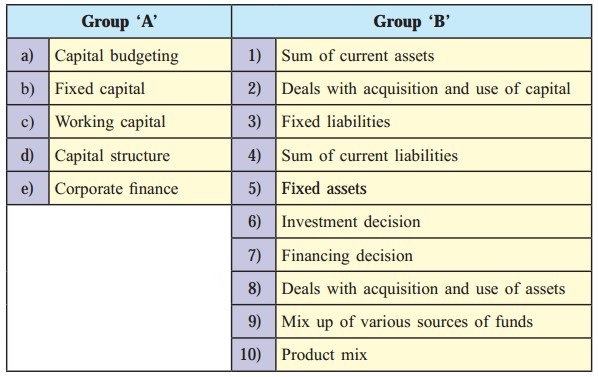
Answer:
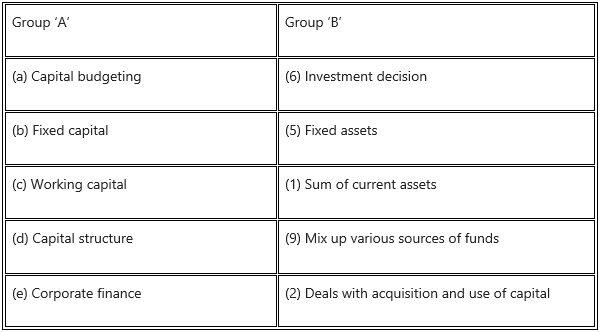
1C. Write a word or term or a phrase that can substitute each of the following statements:
Question 1.
A key determinant of the success of any business function.
Answer:
Finance
Question 2.
The decision of the finance manager ensures that the firm is well-capitalized.
Answer:
Financing decision
Question 3.
The decision of the finance manager to deploy the funds in a systematic manner.
Answer:
Investment decision
Question 4.
Capital is needed to acquire fixed assets that are used for a longer period of time.
Answer:
Fixed capital
Question 5.
The sum of current assets.
Answer:
Gross working capital
Question 6.
The excess of current assets over current liabilities.
Answer:
Networking capital
Question 7.
The process of converting raw material into finished goods.
Answer:
Production cycle
Question 8.
The boom and recession cycle in the economy.
Answer:
Economic Trend
Question 9.
The ratio of different sources of funds in the total capital.
Answer:
Capital Structure
Question 10.
The internal source of financing.
Answer:
Retained earnings
1D. State whether the following statements are True or False:
Question 1.
Finance is related to money and money management.
Answer:
True
Question 2.
The business firm gives a green signal to the project only when it is profitable.
Answer:
True
Question 3.
Corporate finance brings coordination between various business activities.
Answer:
True
Question 4.
Fixed capital is also referred as circulating capital.
Answer:
False
Question 5.
Working capital stays in the business almost permanently.
Answer:
False
Question 6.
The business will require huge funds if assets are acquired on a lease basis.
Answer:
False
Question 7.
The business dealing in luxurious products will require a huge amount of working capital.
Answer:
True
Question 8.
A firm with large-scale operations will require more working capital.
Answer:
True
Question 9.
Liberal credit policy creates a problem of bad debt.
Answer:
True
Question 10.
Financial institutions and banks cater to the working capital requirement of the business.
Answer:
True
1E. Find the odd one.
Question 1.
Land and Building, Plant and Machinery, Cash.
Answer:
Cash
Question 2.
Debenture Capital, Equity Share Capital, Preference Share Capital.
Answer:
Debenture Capital
Question 3.
Fixed Capital, Capital Structure, Working Capital.
Answer:
Capital Structure
1F. Complete the sentences.
Question 1.
Initial planning of capital requirement is made by _____________
Answer:
entrepreneur
Question 2.
When there is boom in economy, sales will _____________
Answer:
increase
Question 3.
The process of converting raw material into finished goods is called _____________
Answer:
production cycle
Question 4.
During recession period sales will _____________
Answer:
decrease
1G. Select the correct option from the bracket.
Question 1.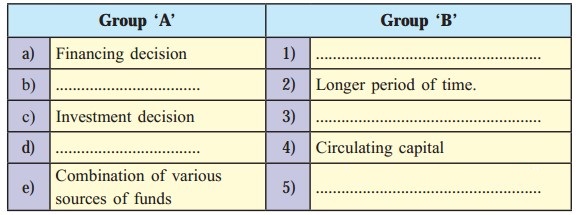
(To have the right amount of capital, deploy funds in a systematic manner, fixed capital, working capital, capital structure, carry dividend at a fixed rate)
Answer:
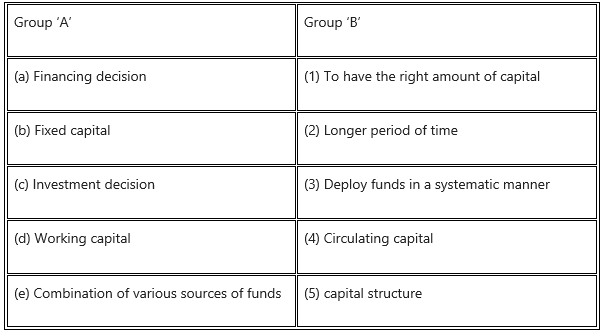
1H. Answer in one sentence.
Question 1.
Define corporate finance.
Answer:
Corporate finance deals with the raising and using of finance by a corporation.
Question 2.
What is fixed capital?
Answer:
Fixed capital is the capital that is used for buying fixed assets that are used for a longer period of time in the business eg. Capital for plant and machinery etc.
Question 3.
What is working capital?/Define working capital.
Answer:
Working capital is the capital that is used to carry out day-to-day business activities and takes into consideration all current assets of the company.
Eg: for building up inventories.
Question 4.
What is the production cycle?
Answer:
The process of converting raw material into finished goods is called the production cycle.
Question 5.
Define capital structure.
Answer:
Capital structure means to mix up various sources of funds in the desired proportion. To decide capital structure means to decide upon the ratio of different types of capital.
1I. Correct the underlined word and rewrite the following sentences.
Question 1.
Finance is needed to pay dividends to debenture holders.
Answer:
Finance is needed to pay interest to debenture holders.
Question 2.
When there is a recession in the economy sales will increase.
Answer:
When there is a boom in the economy sales will increase.
Question 3.
Share is an acknowledgment of a loan raised by the company.
Answer:
A debenture is an acknowledgment of a loan raised by a company.
Question 4.
Equity shares carry dividends at a fixed rate.
Answer:
Preference shares carry dividends at a fixed rate.
2. Explain the following terms/concepts.
Question 1.
Financing decision
Answer:
A financing decision is a right decision that is made by a finance manager of any corporation ensuring that the firm is well capitalized with the right combination of debt and equity, having access to multiple choices of sources of financing.
Question 2.
Investment decision
Answer:
Investment decisions mean capital budgeting i.e. finding investments and deploying them successfully in the business for greater profits.
Question 3.
Fixed capital
Answer:
Fixed capital is the capital that is used for buying fixed assets that are used for a longer period of time in the business. These assets are not meant for. resale. Examples of fixed capital are capital used for purchasing land and building, furniture, plant, and machinery, etc.
Question 4.
Working Capital
Answer:
Working capital is the capital that is used to carry out day-to-day business activities. It takes into consideration all current assets, of the company. It also refers to ‘Gross Working Capital’.
Examples of working capital are
- for building up inventories.
- for financing receivables.
- for covering day-to-day operating expenses.
3. Study the following case/situation and express your opinion.
1. The management of ‘Maharashtra State Road Transport Corporation’ wants to determine the size of working capital.
Question (a).
Being a public utility service provider will it need less working capital or more?
Answer:
MSRTC being a public utility service provider will need less working capital because of a continuous flow of cash from there, customers thus liabilities are taken care of.
Question (b).
Being a public utility service provider, will it need more fixed capital?
Answer:
Being a public utility service provider MSRTC will need a huge amount of funds to acquire fixed assets thus it will need more fixed capital.
Question (c).
Give one example of a public utility service that you come across on a day-to-day basis.
Answer:
The Indian Railways.
2. A company is planning to enhance its production capacity and is evaluating the possibility of purchasing new machinery whose cost is ₹ 2 crore or has alternative of machinery available on a lease basis.
Question (a).
What type of asset is machinery?
Answer:
Machinery is a Fixed Asset.
A fixed asset may be held for 5, 10 or 20 years and more. But if assets are acquired on a lease or rental basis, then less amount of funds for fixed assets will be needed for business.
Question (b).
Capital used for the purchase of machinery is fixed capital or working capital.
Answer:
Capital used for the purchase of machinery is fixed capital.
Question (c).
Does the size of a business determine the fixed capital requirement?
Answer:
Yes. Where a business firm is set up to carry on large-scale operations, its fixed capital requirements are likely to be high.
4. Distinguish between the following.
Question 1.
Fixed Capital and Working Capital
Answer:
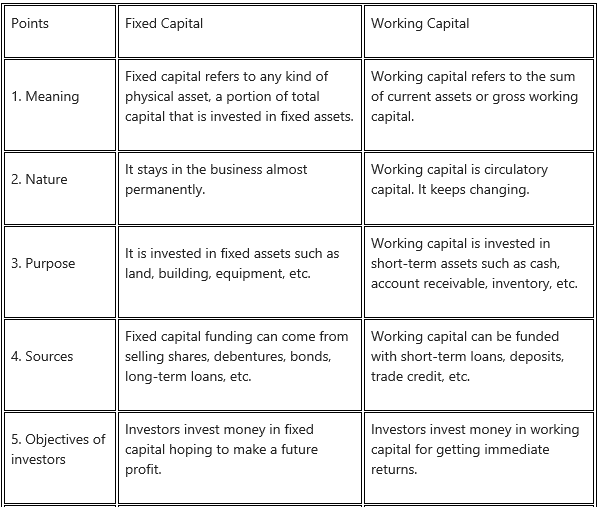
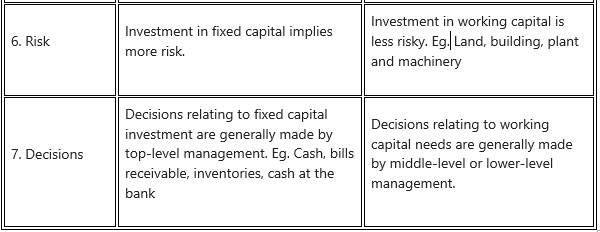
5. Answer in brief:
Question 1.
Define capital structure and state its components.
Answer:
Definition: R.H. Wessel “The long term sources of funds employed in a business enterprise.”
John H. Hampton “A firm’s capital structure is the relation between the debt and equity securities that make up the firm’s financing of its assets.” Thus, the term capital structure means security mix. It refers to the proportion of different securities raised by a firm for long-term finance.
Components/Parts of Capital Structure:
There are four basic components of capital structure. They are as follows:
(i) Equity Share Capital:
- It is the basic source of financing activities of the business. Equity share capital is provided by equity shareholders.
- They buy equity shares and help a business firm to raise necessary funds. They bear the ultimate risk associated with ownership.
- Equity shares carry dividends at a fluctuating rate depending upon profit.
(ii) Preference Share Capital:
- Preference shares carry preferential rights as to payment of dividends and have priority over equity shares for return of capital when the company is liquidated.
- These shares carry dividends at a fixed rate.
- They enjoy limited voting rights.
(iii) Retained earnings:
- It is an internal source of financing.
- It is nothing but ploughing back of profit.
(iv) Borrowed capital: It comprises of the following:
- Debentures: A debenture is an acknowledgment of a loan raised by the company. The company has to pay interest at an agreed rate.
- Term Loan: Term loans are provided by the bank and other financial institutions. They carry fixed rate of interest.
Question 2.
State any four factors affecting fixed capital requirements?
Answer:
(i) Nature of business:
- The nature of business certainly plays a role in determining fixed capital requirements. They need to invest a huge amount of money in fixed assets.
- e.g. Rail, road, and other public utility services have large fixed investments.
- Their working capital requirements are nominal because they supply services and not the product.
- They deal in cash sales only.
(ii) Size of business:
The size of a business also affects fixed capital needs. A general rule applies that the bigger the business, the higher the need for fixed capital. The size of the firm, either in terms of its assets or sales, affects the need for fixed capital.
(iii) Scope of business:
Some business firms that manufacture the entire range of their production would require a huge investment in fixed capital. However, those companies that are labour intensive and who do not use the latest technology may require less fixed capital and vice versa.
(iv) Extent of lease or rent:
Companies who take their assets on a lease basis or on a rental basis will require less amount of funds for fixed assets. On the other side, firms that purchase assets will naturally require more fixed capital in the initial stages.
Question 3.
What are Corporate Finance and State’s two decisions which are basic of corporate finance?
OR
Write short note on Corporate Finance
Answer:
Corporate finance deals with the raising and using of finance by a corporation. It includes various financial activities like capital structuring and making investment decisions, financial planning, capital formation, and foreign capital, etc. Even financial organisations and banks play a vital role in corporate financing.
Henry Hoagland expresses, “Corporate Finance deals primarily with the acquisition and use of capital by the business corporation”.
Following two decisions are the basis of corporate finances:
(i) Financing decision:
Every business firm must carefully estimate its capital needs i.e. working capital and fixed capital. The firm needs to mobilize funds from the right sources also maintaining the right combination of debt capital and equity capital. For this balance, a company may go for or raise equity capital or even opt for borrowed funds by way of debentures, public deposits term loans, etc. to raise funds.
(ii) Investment decision:
Once the capital needs are accessed, the finance manager needs to take correct decisions regarding the use of the funds in a systematic manner, productively, using effective cost control measures to generate high profits. Finding investments through proper decisions and using them successfully in business is called ‘capital budgeting
6. Justify the following statements.
Question 1.
The firm has multiple choices of sources of financing.
Answer:
- Business firms require finance in terms of working capital and fixed capital.
- Funds are required at different stages of business.
- The company can raise funds from various sources i.e. from internal and external sources.
- Internal sources could be cash inflows on sales turnover, income from investments, and retained earnings.
- External sources can be obtained for short-term requirements through cash credit, overdraft trade credit, discounting bills of Exchange issues of commercial paper, etc.
- For long-term needs, a firm can meet its financing needs through the issue of shares, debentures, bonds, public deposits, etc. Thus, it is rightly said that the firm has multiple choices of sources of financing.
Question 2.
There are various factors affecting the requirements of fixed capital.
Answer:
- Fixed capital being long-term capital is required for the development and expansion of the company.
- The nature and size of a business have a great impact on fixed capital. Manufacturing businesses require huge fixed capital whereas trading organizations like retailers require less fixed capital.
- Methods of acquiring assets on rentals or on a lease/installment basis will require less amount of fixed assets.
- If fixed assets are available at low prices and concessional rates then it would reduce the need for investment in fixed assets.
- International conditions and economic trends like a boom period will require high investment in fixed assets and a recession will lead to less requirement.
- Similarly, consumer preferences, competition, and highly demanded goods and services will require a large amount of fixed capital. E.g. Mobile phones. Thus, it is rightly said that there are various factors affecting the requirements of fixed capital.
Question 3.
Fixed capital stays in the business almost permanently.
Answer:
Factors determining fixed capital requirements are:
- Fixed capital refers to capital invested for acquiring fixed assets.
- These assets are not meant for resale.
- Fixed capital is capital used for purchasing land and building, furniture, plant, and machinery, etc.
- Such cap al is usually required at the time of the establishment of a new company.
- Existing companies may also need such capital for their expansion and development, replacement of equipment, etc.
- Modern industrial processes require the increased use of heavy automated machinery. Thus, it is rightly said that fixed capital stays in the business almost permanently.
Question 4.
Capital structure is composed of owned funds and borrowed funds.
Answer:
- Capital structure means to mix up of various sources of funds in desired proportions.
- To decide capital structures means to decide upon the ratio of different types of capital.
- A firm’s capital structure is the relation between the debt and equity securities that make up the firm’s financing of its assets.
- The capital structure is composed of own funds which include share capital, free serves, and surplus, and borrowed funds which represent debentures, bank loans, and long-term loans provided by financial institutions.
- Thus capital structure = Equity share capital + preference share capital + reserves + debentures.
- Thus, it is rightly said that capital structure is composed of owned funds and borrowed funds.
Question 5.
There are various factors affecting the requirement of working capital.
Answer:
- The nature and size of a business affect the requirement of working capital. Trading or merchandising firms and big retail enterprises need a large amount of capital compared to small firms which need a small amount of working capital.
- If the period of the production cycle is longer then the firm needs more amount of working capital. If the manufacturing cycle is short, it requires less working capital.
- During the boom period sales will increase leading to increased investment in stocks, thus requiring additional working capital and during the recession, it is vice versa.
- Along with the expansion and growth of the firm or company in terms of sales and fixed assets, the requirement of working capital increases.
- If there is proper coordination, communication, and co-operation between production and sales departments then the requirement of working capital is less.
- A liberal credit policy increases the possibility of bad debts and in such cases, the requirement of working capital is high, whereas a firm making cash sales requires less working capital.
7. Answer the following questions.
Question 1.
Discuss the importance of Corporate Finance?
Answer:
Corporate finance deals with the raising and utilizing of finance by a corporation. It also deals with capital structuring and making investment decisions, financial planning of capital, and the money market. The finance manager should ensure that:
The firm has adequate finance and it’s being utilized effectively;
Generate minimum return for its owners.
The importance of Corporate Finance are as follows:
(i) Helps in decision making:
Most important decisions of business enterprises are made on the basis of availability of funds, as without finance any function of business enterprise is difficult to be performed independently. Obtaining the funds from the right sources at a lower cost and productive utilization of funds would lead to higher profits. Thus corporate finance plays a significant role in the decision-making process.
(ii) Helps in raising capital for a project:
A new business venture needs to raise capital. Business firms can raise funds by issuing shares, debentures, bonds or even by taking loans from the banks.
(iii) Helps in Research and Development
Research and Development need to be undertaken by firms for growth and expansion of business and to enjoy a competitive advantage. Research and development mostly involve lengthy and detailed technical work for the execution of projects. Through surveys and market analysis etc. companies may have to upgrade old products or develop new products to face competition and attract consumers. Thus the availability of adequate finance helps to generate high efficiency.
(iv) Helps in the smooth running of the business firm:
A smooth flow of corporate finance is important to pay the salaries of employees on time, pay loans, and purchase the required raw materials. At the same time finance is needed for sales promotion of existing products and more so for the launch of new products effectively.
(v) Brings co-ordination between various activities:
Corporate finance plays a significant role in the coordination and control of all activities in an organization. Production activity requires adequate finance for the purchase of raw materials and meeting other day-to-day financial requirements for the smooth running of the production unit. If the production increases, sales will also increase by contributing the income of the concern and profit to increase.
(vi) Promotes expansion and diversification:
Corporate finance provides money for the purchase of modern machines and sophisticated technology. Modern machines and technology help to improve the performance of the firm in terms of profits. It also helps the firm to expand and diversify the business.
(vii) Managing risk:
Companies have to manage several risks such as sudden fall in sales, loss due to natural calamity, loss due to workers strikes, change in government policies, etc. Financial aids help in such situations to manage such risks.
(viii) Replace old assets:
Assets like plants and machinery have become old and outdated over the years. Finance is required to purchase new assets or replace the old assets with new assets having new technology and features.
(ix) Payment of dividend and interest:
Finance is needed to pay the dividend to shareholders, interest to creditors, bank, etc.
(x) Payment of taxes/fees:
The company has to pay taxes to the government such as Income tax, Goods and Service Tax (GST), and fees to the Registrar of Companies on various occasions. Finance is needed for paying these taxes and fees.
Question 2.
Discuss the factors determining working capital requirements?
Answer:
Working Capital = Current Assets – Current Liabilities.
In other words, it is also called ‘Circulating Capital’. Also, refer to ‘GROSS WORKING CAPITAL.’ Management needs to determine the size of working capital with reference to the economic environment and other aspects within the business firm.
Factors determining/influencing working capital requirements are as follows:
(i) Nature of Business:
The working capital requirements are highly influenced by the nature of the business. Trading/ merchandising forms concerned with the distribution of goods require a huge amount of working capital to maintain a large stock of the variety of goods to meet customers’ demands are extend credit facilities to attract them. Whereas public utility concerns have to maintain small working capital because of a continuous flow of cash from their customers.
(ii) Size of business:
The size of a business also affects the requirements of working capital. Size of the firm refers to the scale of operation i.e. a firm with large scale operations will require more working capital and vice versa.
(iii) Volume of Sales:
The volume of sales and the size of the working capital have a direct relationship with each other. If the volume of sales increases there is an increase in the amount of working capital.
(iv) Production cycle:
The process of converting raw material into finished goods is called the ‘production cycle’. If the production cycle period is longer, the firm needs more amount of working capital. If the manufacturing cycle is short, it requires less working capital.
(v) Business cycle:
When there is a boom in the economy, sales will increase resulting in to increase in investment in stock. This will require additional working capital. During a recession period, sales will decline and consequently, the need for working capital will also decrease.
(vi) Terms of purchases and sales:
If credit terms of purchase are favourable and terms of sales are less liberal, then the requirement of cash will be less. Thus, the working capital requirement will be reduced.
A firm that enjoys more credit facilities needs less working capital. On the other hand, if a firm does not get proper credit for purchases and adopts a liberal credit policy for sales if requires more working capital.
(vii) Credit Control:
Credit control includes the factors such as volume of credit sales, the terms of credit sales, the collection policy etc. A firm with a good credit control policy will have more cash flow reducing the working capital requirement. Whereas if the firm’s credit policy is liberal there would be more requirements of the working capital.
(viii) Growth and Expansion:
Those firms which are growing and expanding at a rapid pace need more working capital compared to those firms which are stable in their growth.
(ix) Management ability:
The requirement of working capital is reduced if there is proper coordination in the production and distribution of goods. A firm stocking on heavy inventory calls for a higher level of working capital.
(x) External factors:
If the financial institutions and banks provide funds to the firm as and when required, the need for working capital is reduced.